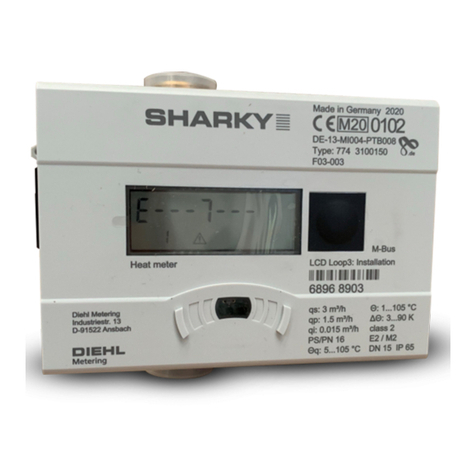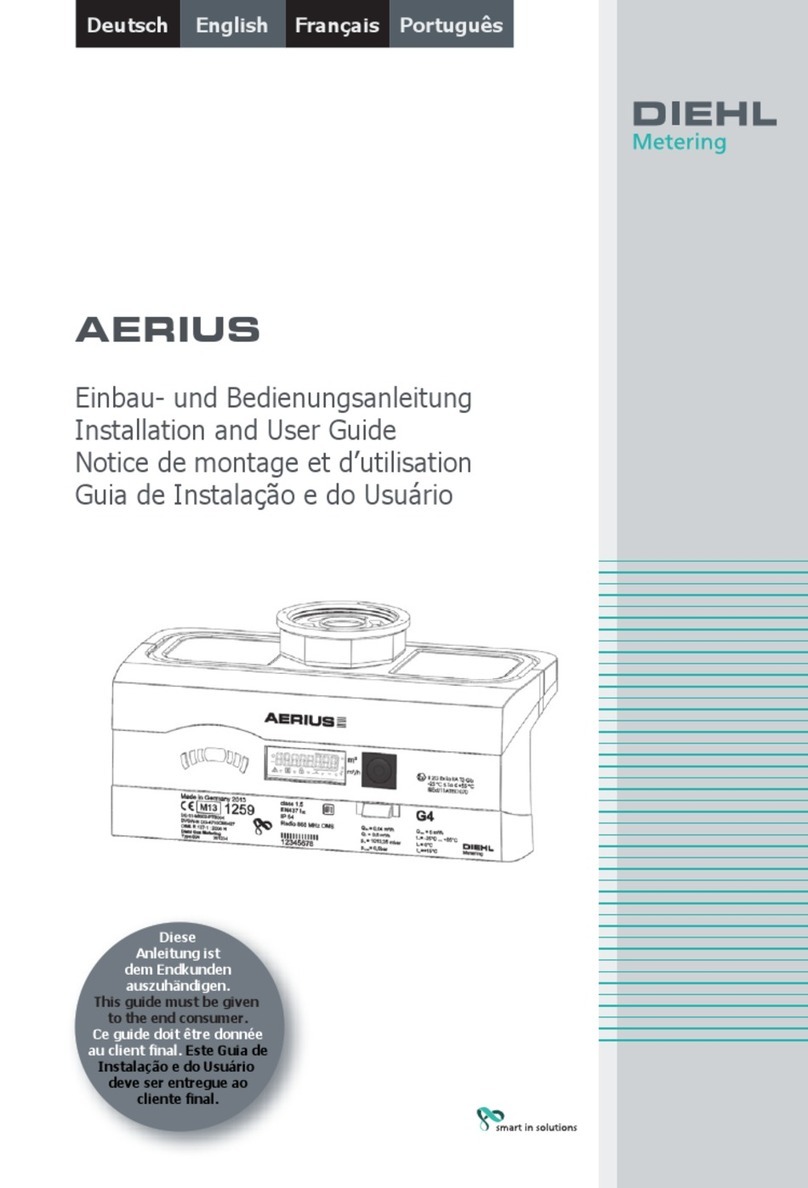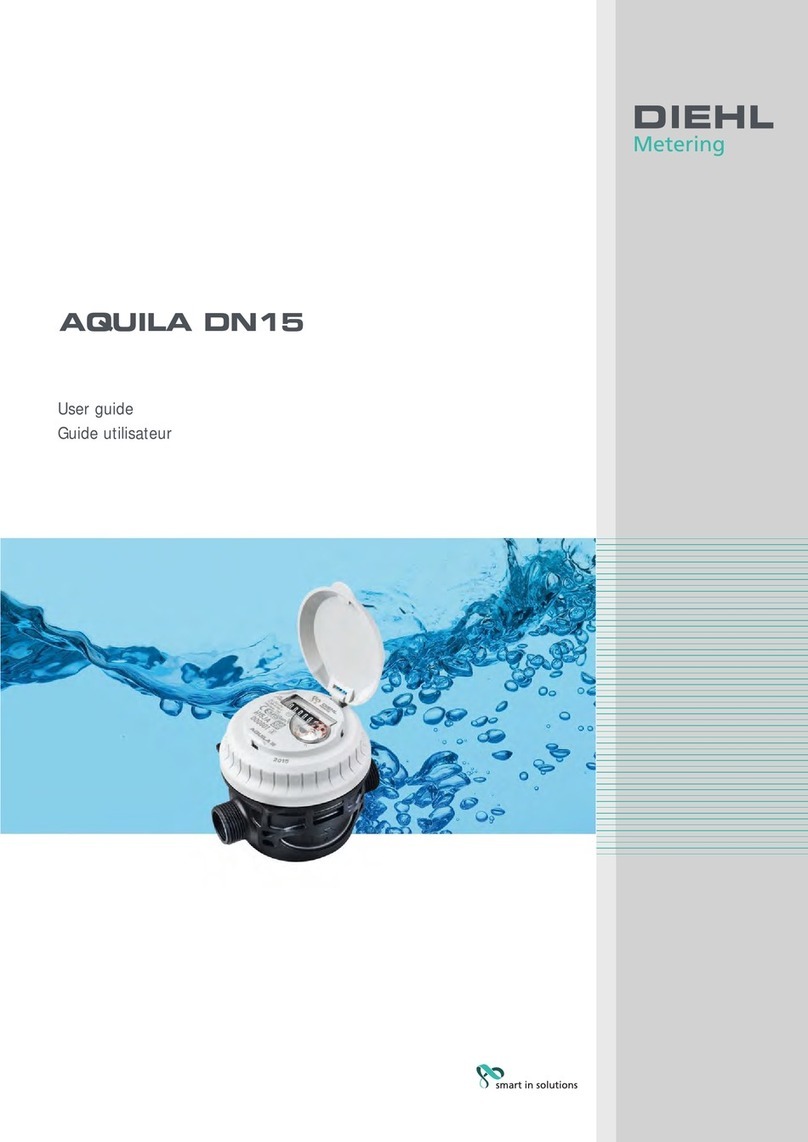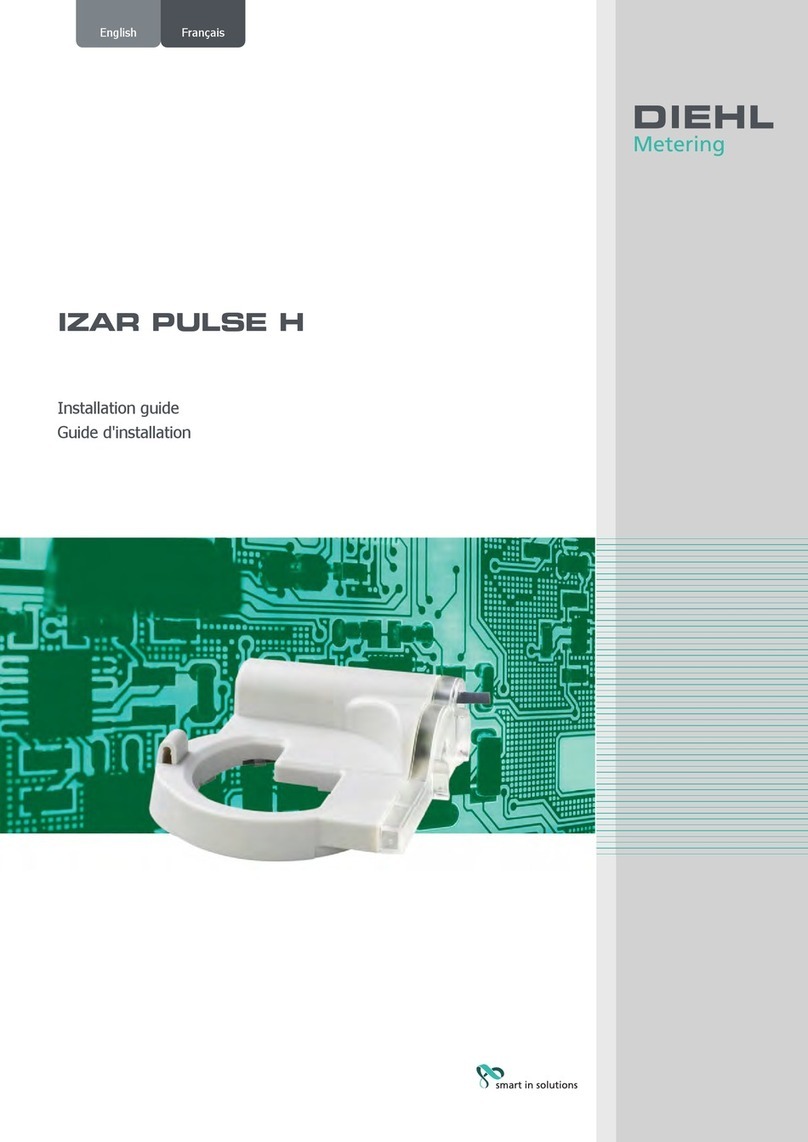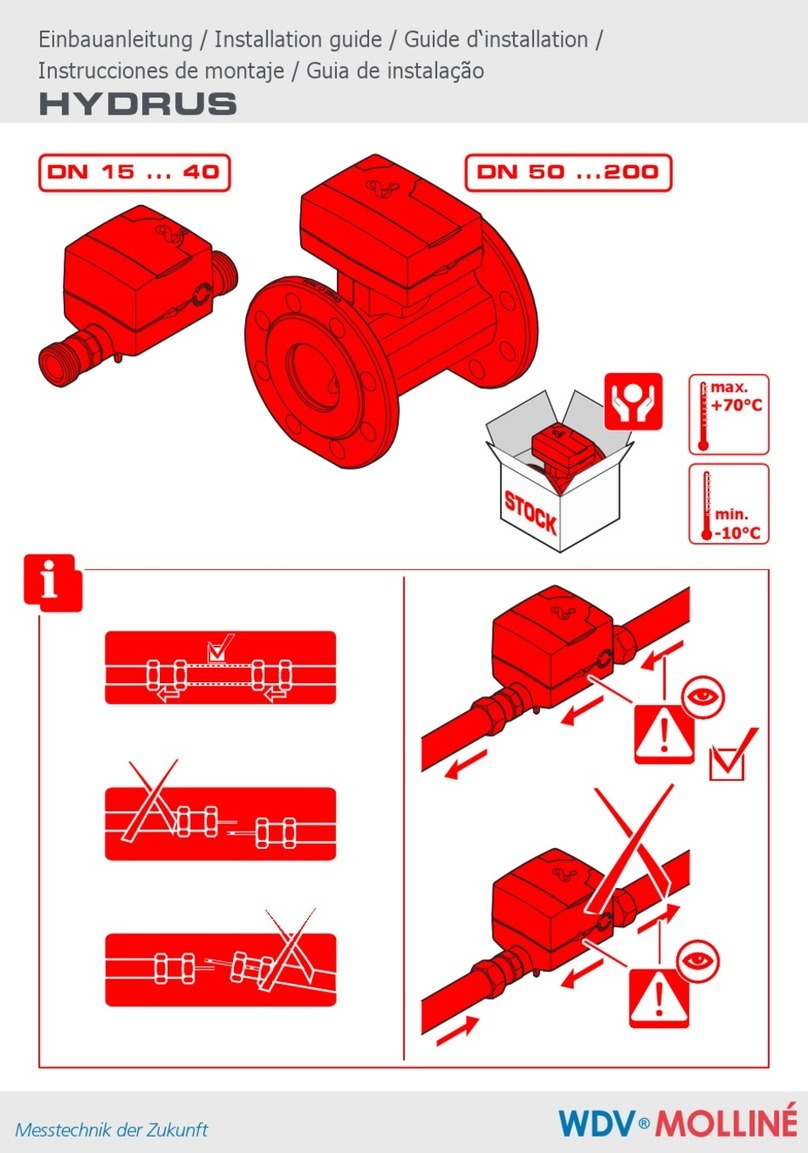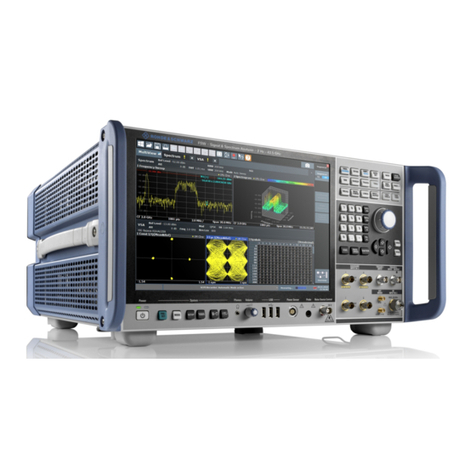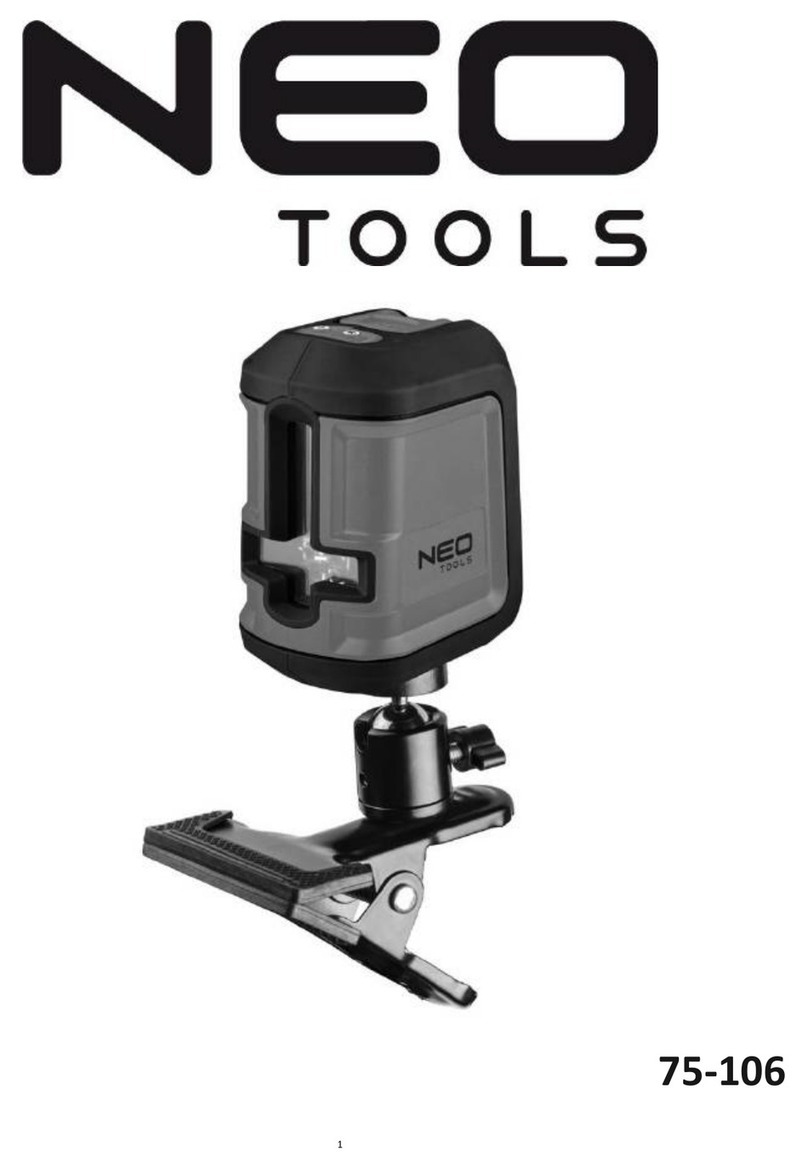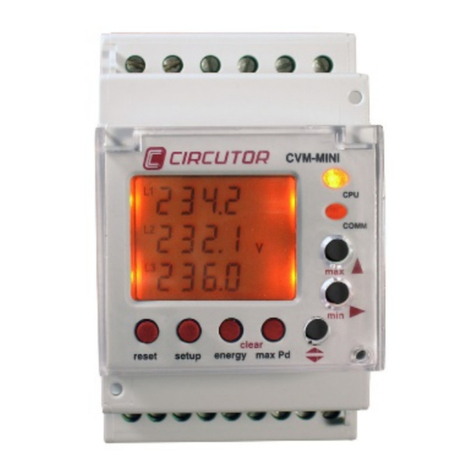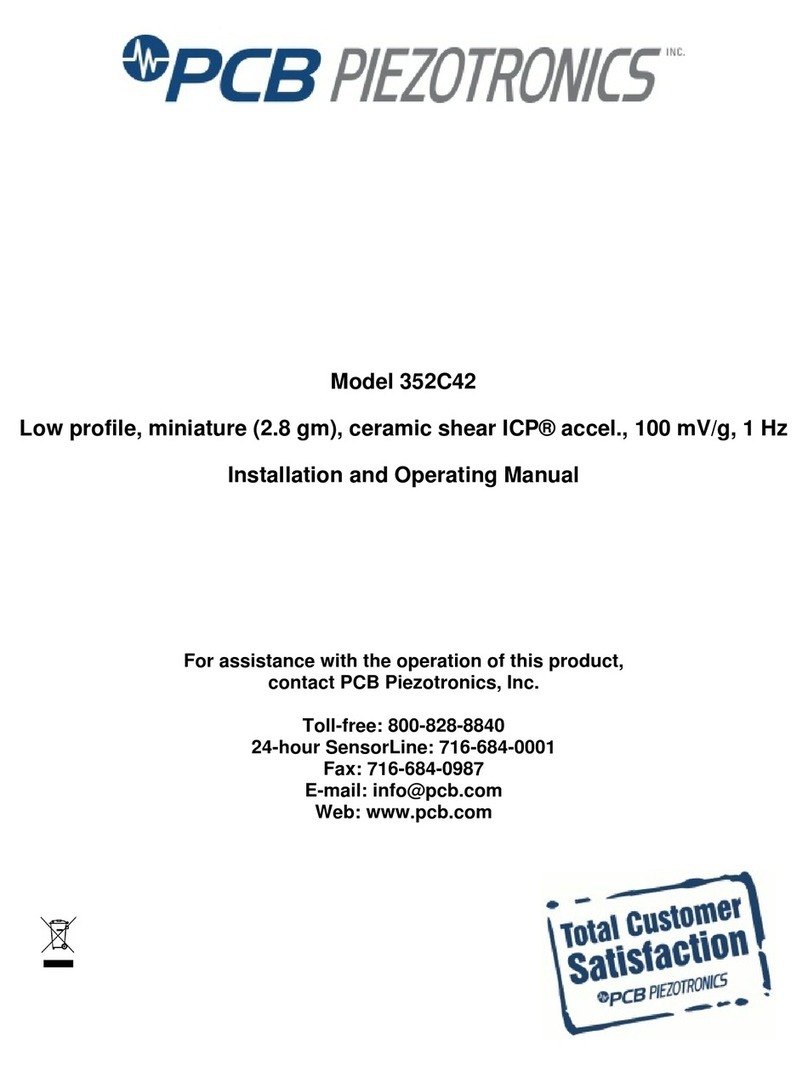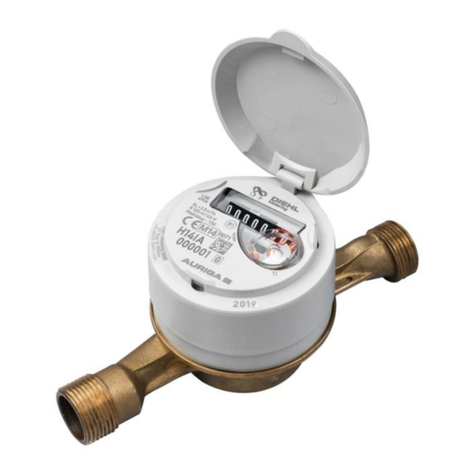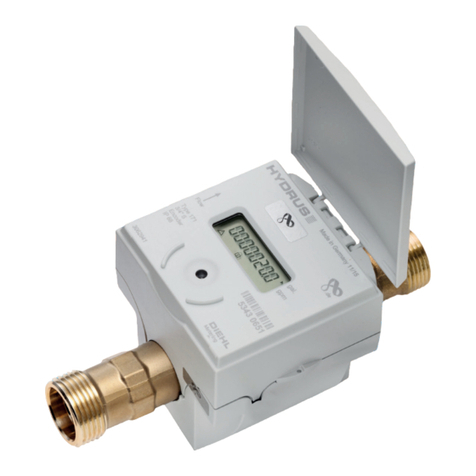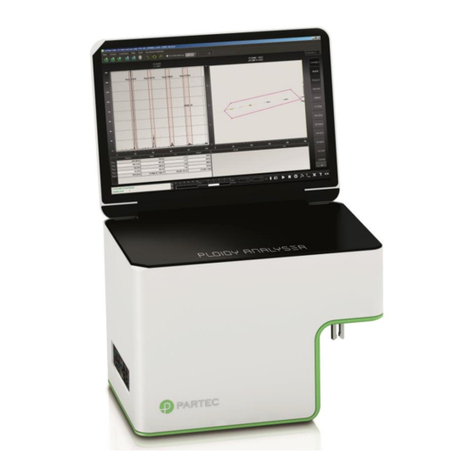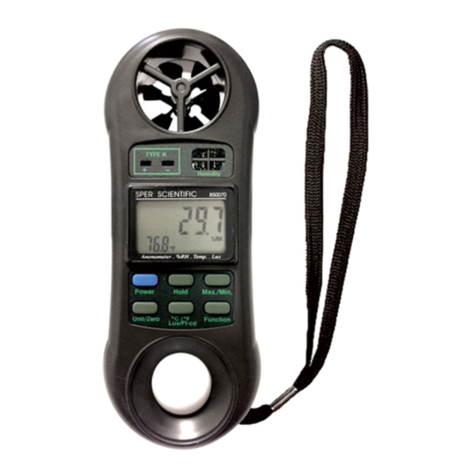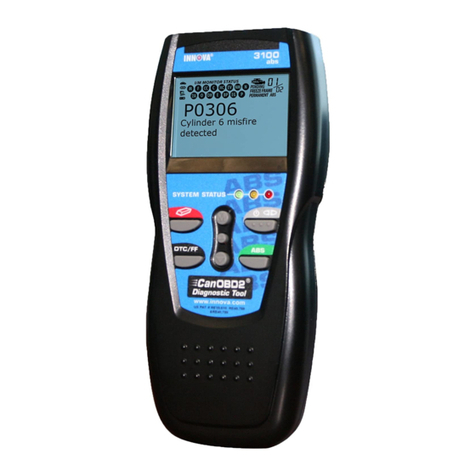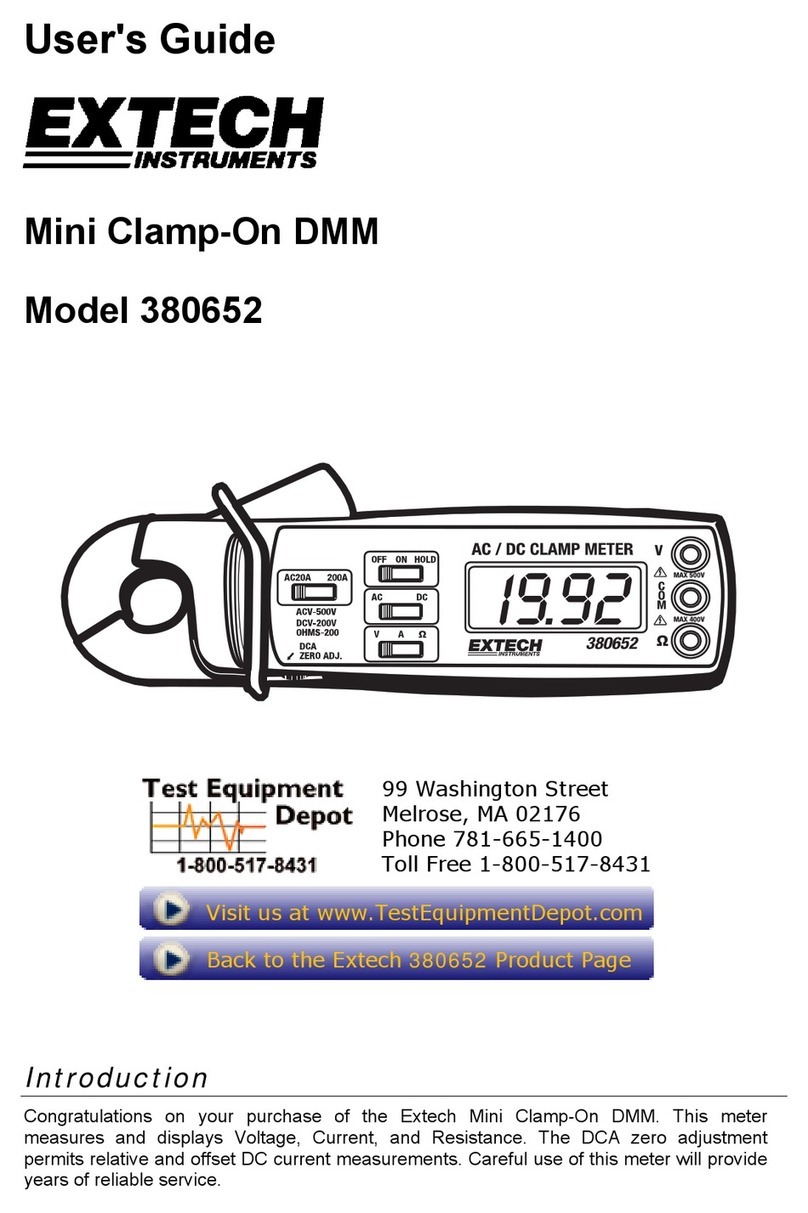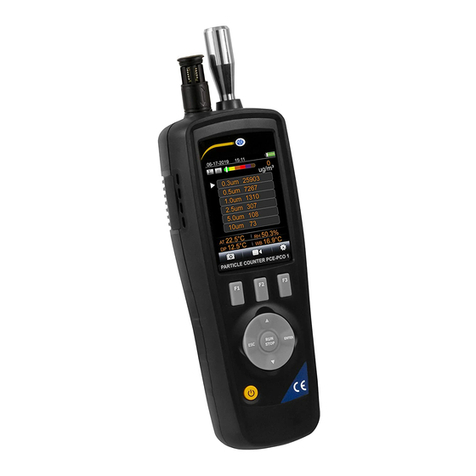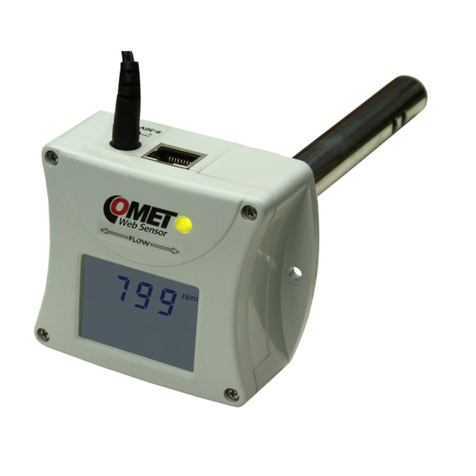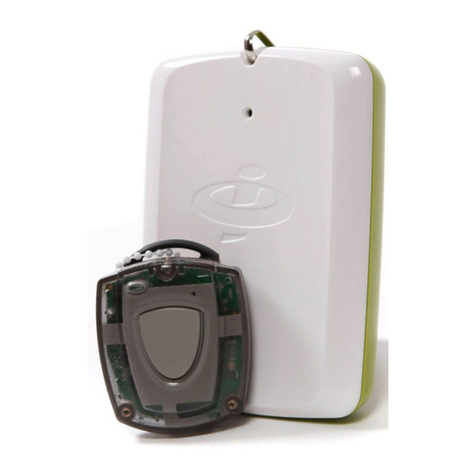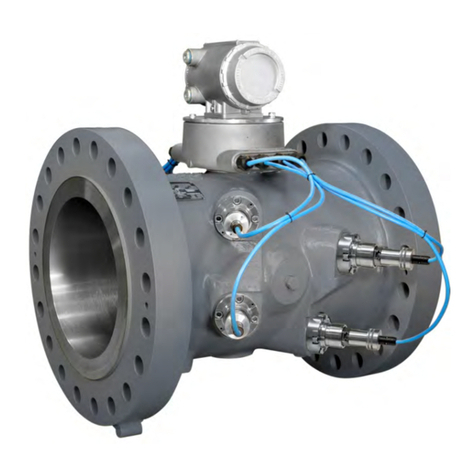
Mat.-Nr. 3063769 • 1/6/2017 Technische Änderungen vorbehalten • Technical changes reserved
Installation guide / Guide d‘installation
IZAR RADIO EXTERN AIR
English Français
1. Généralités
La présente notice s’adresse à du personnel qualié dans le domaine de
l’électricité. Le personnel doit être formé à l’installation et à l’utilisation d’ap-
pareils électriques ainsi qu’au fonctionnement d’un réseau M-Bus.
2. Description de produit
Le IZAR RADIO EXTERN AIR est une unité de mesure pour la température
et l‘humidité. Les données sont envoyées au destinataire mobile ou sta-
tionnaire (IZAR RDC, IZAR RECEIVER BT) dans les intervalles d‘émission
réglables. Le télégramme correspond aux spécications OMS.
2.1 Lecture des données
Mobile
L‘IZAR TABLET recueille des données par rapport au IZAR RECEIVER BT en
passant. Après le relevé, les données sont directement envoyées à l‘ordina-
teur central via IZAR@NET ou à IZAR PLUS PORTAL.
Stationnaire :
IZAR RDC STANDARD ou IZAR RDC PREMIUM collecte et stocke les don-
nées, pour les envoyer d‘une manière cyclique au serveur FTP central. La
visualisation des données peut être effectuée via IZAR@NET ou IZAR PLUS
PORTAL.
3. Utilisation
Les capteurs sont exclusivement prévus pour le fonctionnement dans des
locaux fermés et secs, et ils doivent uniquement être utilisés là-bas.
Toute manipulation ou installation se déroulant incorrectement
et non conformément aux prescriptions dégage le constructeur
de toute responsabilité. Celle-ci incombe exclusivement à son
auteur.
4. Fournitures
IZAR RADIO EXTERN AIR (capteur avec boîtier)
2 piles alcalines de taille AA.
Kit de montage composé de 2 chevilles (5 mm) et de 2 vis (3 x 30 mm)
Notice
5. Montage
5.1 Lieu de montage (support mural)
Protéger l’IZAR RADIO EXTERN AIR contre l’exposition directe aux rayons
du soleil.
Par ailleurs, monter le capteur avec un espace de >1,5m par rapport au
mur extérieur, au sol, à la porte extérieure et au radiateur.
On obtient ainsi une mesure plus précise avec moins de grandeurs d’in-
uence.
5.2 Ouvrir le verrouillage (voir g. I)
Introduisez un tournevis pour vis à tête fendue successivement dans
chacun des orices de verrouillage sur le couvercle du boîtier pour déta-
cher le verrouillage.
Levez le couvercle du boîtier et retirez-le.
5.3 Fixer la plaque de montage au mur
La plaque de montage est dotée des repères UP et DOWN pour l’orientation
correcte.
Montez les plaques de montage à l’endroit souhaité à l’aide des chevilles
et des vis livrées.
Il est interdit de laisser dépasser les têtes de vis par la bordure
de la plaque de montage ; le système électronique risque sinon
de se retrouver endommagé lors de la fermeture du boîtier !
Les trous oblongs disposés en cercle ont un écartement de 60 mm,
ils peuvent donc être utilisés pour le montage facile sur une boîte
de branchement encastrée ou montée dans un mur creux.
5.4 Carte de circuits imprimés
Retirer
Faîtes basculer la carte de circuits imprimés hors du couvercle de l’ap-
pareil et retirez-la (voir g. II).
Congurer
Du côté de l’équipement, il est maintenant possible de régler les para-
mètres de service souhaités à l’aide de l’interrupteur DIP.
Les informations sur les interrupteurs se trouvent sur la carte de circuits
imprimés (voir g. III).
Encryption
Enable
Disable
1
ON
OFF
Intervalle
TX
1 min
5 min
10 min
15 min
3
ON
OFF
ON
OFF
4
ON
ON
OFF
OFF
Mode Bus wM
Mode S
Mode T
2
ON
OFF
Insérer les piles (voir g. IV)
Le capteur est équipé d’un contact anti-sabotage. Entre
l’insertion des piles et le montage terminé, est autorisé un
maximum de 2 cycles d’émission (p.ex. en cas de cycle d’émis-
sion de 5 min., 10 min. maxi de temps de montage). Sinon,
une erreur permanente est transmise dans le télégramme.
Les prescriptions relatives aux décharges électrostatiques
(DES) en vigueur doivent être respectées. Toute responsabilité
est déclinée à l'égard de dommages (notamment sur l'électro-
nique) imputables à leur non-respect.
Insérer les piles (cellules AA à tension de 1,5 V) en respectant la polarité.
Montage nal
Insérer la carte de circuits imprimés avec les piles par l’avant dans le
couvercle du boîtier.
Respecter l’orientation !
L’orientation est marquée avec des èches vers le haut sur la carte
de circuits imprimés et sur l’étiquette du couvercle du boîtier.
Faire encranter le couvercle de boîtier avec la carte de circuits imprimés
sur la plaque de montage (voir gure V). Pour y parvenir, accrocher le
couvercle de boîtier sur la bordure supérieure de la plaque de montage
puis enfoncer de manière ferme.
6. Caractéristiques techniques
Portée radio Jusqu'à 600m (dépend de l'environ-
nement)
Interface de programmation DIP-switches
Alimentation électrique Contiennent 2xAA batteries (interchan-
geable)
Durée de vie de la pile Jusqu'à 6 ans (intervalle d'émission 1 m)
Jusqu'à 12 ans (intervalle d'émission
15 m)
La durée de vie de la batterie dépend de
la puissance des batteries utilisées
Intervalle d'émission 1 min, 5 min, 10 min, 15 min
Précision Typique ±2 % entre 20-80 %; typique
±0,3 °C entre -10 °C et 55 °C
Plage des températures de
service
-10 ... +55 °C
L'humidité de l'air 20 ... 80 % (sans condensation)
7. Transport et stockage
Désactiver la radio avant d‘expédier par voie aérienne tout
instrument de mesure / composant à fréquence radio.
8. Faits concernant l‘environnement
L‘appareil ne doit pas être jeté dans les ordures ménagères.
Retournez-le au fabricant pour le recyclage.
9. Certications et conformité
Le soussigné, Diehl Metering, déclare que l’équipement radioélectrique
du type IZAR RADIO EXTERN AIR est conforme à la directive 2014/53/
UE. Le texte complet de la déclaration UE de conformité est disponible à
l’adresse internet suivante:
http://www.diehl.com/fr/diehl-metering/produits-solutions/documentation-
a-telecharger/.
Veuillez sélectionner le partenaire « Diehl Metering GmbH » et la rubrique
« Systèmes ».
1. General
This manual is intended for trained specialist personnel in the electricity
sector. The personnel must be trained in the installation and handling of
electrical equipment and in the function of an M bus network.
2. Product description
The IZAR RADIO EXTERN AIR is an electronic measuring unit for temper-
ature and humidity. The data are sent to a mobile or stationary receiver
(IZAR RDC, IZAR RECEIVER BT) in adjustable sending intervals. The tele-
gram corresponds to OMS specications.
2.1 Data readout
Mobile
The IZAR TABLET collects data in connection with the IZAR RECEIVER BT
when passing by. The data are directly sent with IZAR@NET to the central
computer or to the IZAR PLUS PORTAL after a read-out tour.
Stationary:
An IZAR RDC STANDARD or IZAR RDC PREMIUM collects and saves the
data to transfer these cyclically to a central FTP server. The visualization
can be provided by IZAR@NET or IZAR PLUS PORTAL.
3. Use
The sensors are intended for operation only in closed, dry indoor rooms and
may only be employed there.
Any manipulation or installation that is not properly carried out
and does not conform to the regulations will waive any
responsibility on the part of the manufacturer. In this case, the
responsibility lies solely with the originator.
4. Scope of supply
IZAR RADIO EXTERN AIR (sensor with housing)
2 alkaline batteries, size AA
Installation kit consisting of 2 dowels (5 mm) and 2 screws (3 x 30 mm)
Guide
5. Installation
5.1 Installation location (wall mounting)
Protect the IZAR RADIO EXTERN AIR from direct sunlight.
Furthermore, install the sensor at a distance of >1.5 m from the outer wall,
the oor, the outside door and the radiator.
This ensures a more accurate measurement with less interference param-
eters.
5.2 Open catch (see Fig. I)
Insert a suitable at screwdriver into the latching openings of the hous-
ing cover in turn to release the catches.
Lift off and remove the housing cover.
5.3 Fastening the mounting plate to the wall
The mounting plate is marked with UP and DOWN for correct orientation.
Install the mounting plate at the desired location using the dowels and
screws supplied.
The screw heads must not protrude beyond the end of the
mounting plate, as otherwise the electronics could be dam-
aged when closing the housing!
The slots arranged in a circle have intervals of 60 mm and can
be used for simple mounting on a ush-mounted or cavity wall
box.
5.4 Circuit board
Remove
Tip the circuit board out of the housing cover and remove (see Fig. II).
Congure
The desired operating parameters can now be set on the component
mounting side using the DIP switches.
Information on the switches can be found on the circuit board (see Fig. III).
Encryption
Enable
Disable
1
ON
OFF
TX interval
1 min
5 min
10 min
15 min
3
ON
OFF
ON
OFF
4
ON
ON
OFF
OFF
wM bus mode
S mode
T mode
2
ON
OFF
Insert batteries (see Fig. IV)
The sensor is equipped with a sabotage contact. No more than
2 transmission cycles may pass between the insertion of the
batteries and the completion of installation (e.g. with 5
minutes transmission cycle, max. 10 minutes installation time).
Otherwise a permanent error is transmitted in the telegram.
The relevant ESD regulations (electrostatic discharge) must be
observed. No responsibility is accepted for damage (especially
to the electronics), resulting from non-observation of the rules.
Insert batteries (AA cells with 1.5 V) with the correct polarity.
Final assembly
Place the circuit board with the batteries facing forward into the hous-
ing cover.
Pay attention to the alignment!
The orientation is indicated by upward arrows on the circuit
board and on the label of the housing cover.
Clip housing cover incl. circuit board onto the mounting plate (see Fig.
V). To do this, hook the housing cover onto the upper edge of the
mounting plate and press on rmly.
6. Technical data
Radio range Up to 600 m (depends on environmen-
tal conditions)
Programming interface DIP-switches
Power supply Containing 2xAA batteries (replaceable)
Battery life Up to 6 years (sending interval 1min)
Up to 12 years (sending interval 15min)
The battery life depends from the
performance of the used battery.
Sending interval 1 min, 5 min, 10 min, 15 min
Accuracy Typical ±2 % within the range between
20-80 %; typical ±0,3 °C in the range
between -10 °C and 55 °C
Operating temperature range -10 ... +55 °C
Relative humidity 20 ... 80% (non-condensing)
7. Transport and storage
When sending wireless measuring instruments / components
by air, deactivate the wireless before shipping.
8. Environmental note
The device must not be disposed together with the domestic waste.
Return it to the manufacturer for recycling.
9. Approval and Conformity
Hereby, Diehl Metering declares that the radio equipment type
IZAR RADIO EXTERN AIR is in compliance with Directive 2014/53/EU. The
full text of the EU declaration of conformity is available at the following
internet address: http://www.diehl.com/en/diehl-metering/products-
solutions/product-download/. Please select the partner "Diehl Metering
GmbH" and the product area "Metering Systems".
www.diehl.com/metering
Diehl Metering GmbH
Industriestrasse 13
91522 Ansbach
Phone: +49 981 1806-0
Fax: +49 981 1806-615





